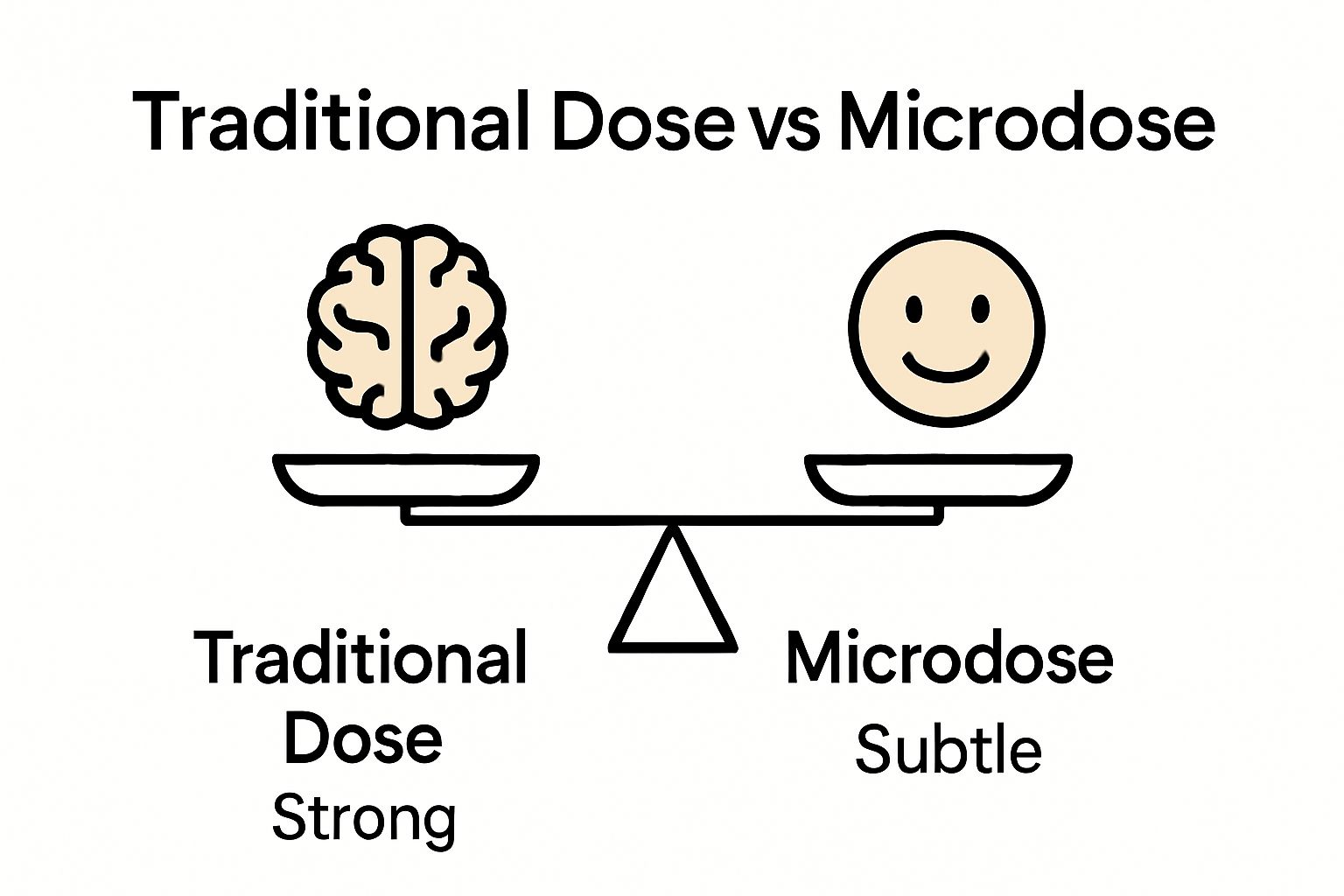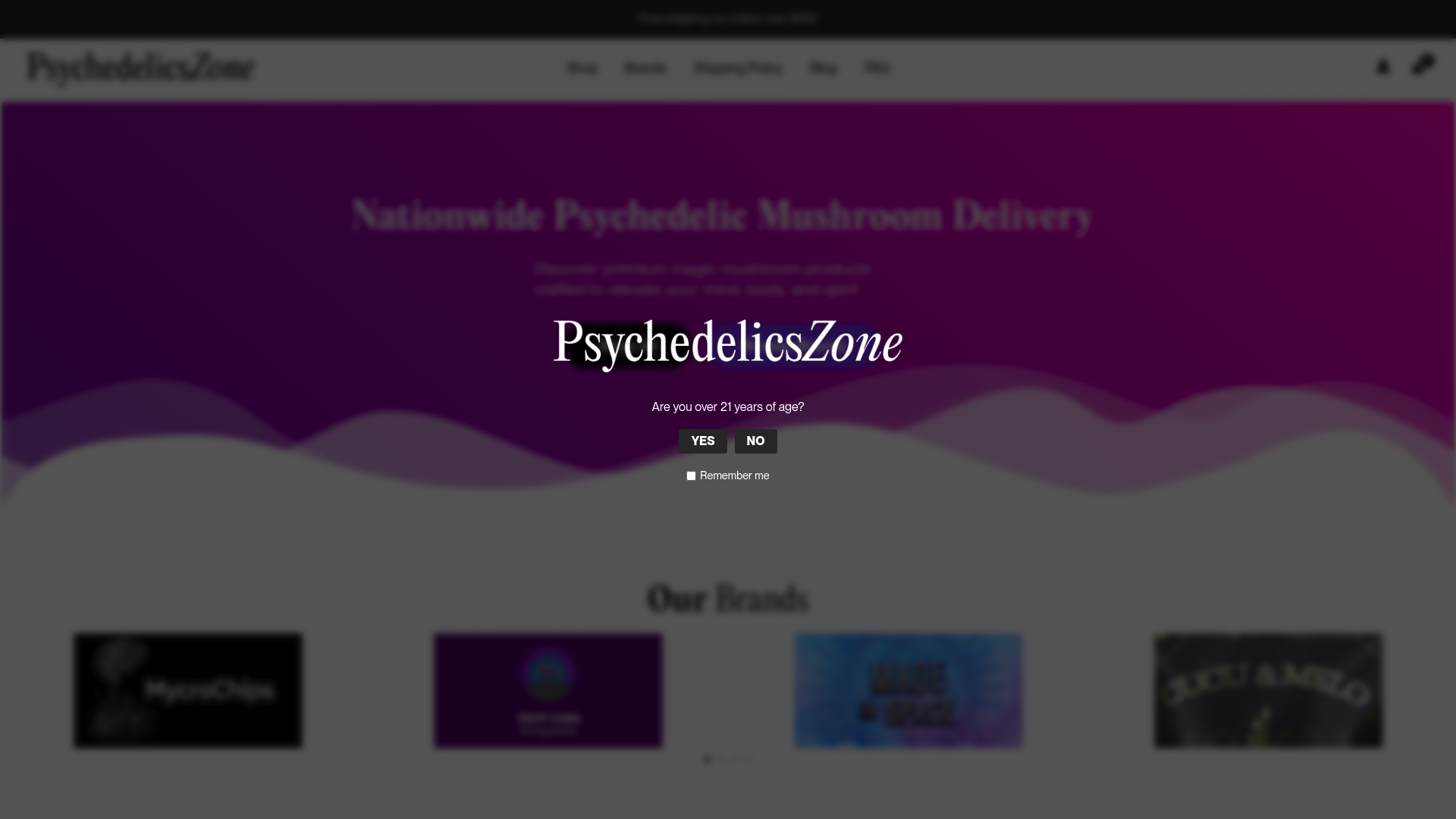Psychedelic microdosing is getting serious attention as people look for new ways to improve their mood and mental clarity. Microdosing means taking just one-tenth to one-twentieth of a normal dose, so low you feel zero classic psychedelic effects. That sounds counterintuitive, right? Some of the most promising changes happen not because you trip, but because your brain starts adapting in ways science is only just starting to measure.
Table of Contents
- Defining Psychedelic Microdosing: An Introduction
- The Importance of Psychedelic Microdosing in Modern Wellness
- How Psychedelic Microdosing Affects the Brain and Body
- Exploring Research and Evidence Behind Microdosing
- Cultural and Historical Context of Psychedelic Microdosing
Quick Summary
| Takeaway | Explanation |
|---|---|
| Psychedelic microdosing involves small, controlled doses. | Users take 1/10 to 1/20 of typical doses to achieve benefits without hallucinations. |
| It may improve mental health and emotional regulation. | Users report enhancements in mood, reduced anxiety, and resilience through minimal substance interaction. |
| Microdosing aims for cognitive enhancement. | Practitioners seek improved creativity, focus, and emotional intelligence while avoiding full psychedelic experiences. |
| Scientific research is still evolving. | Current studies face challenges in standardization and differentiating genuine effects from placebos. |
| Cultural roots play a significant role in microdosing. | Ancient practices using psychedelics for healing and transformation inform contemporary applications and perceptions. |
Defining Psychedelic Microdosing: An Introduction
Psychedelic microdosing represents an emerging practice of consuming extremely small quantities of psychoactive substances to potentially enhance cognitive function, emotional well-being, and personal growth. Scientific research suggests this approach involves taking sub-perceptual doses that do not produce traditional hallucinogenic experiences.
The Fundamental Concept
At its core, psychedelic microdosing involves consuming approximately one-tenth to one-twentieth of a standard recreational dose of substances like psilocybin mushrooms or LSD. The critical distinction is that these doses are intentionally calibrated to be below the threshold of noticeable psychoactive effects.
 Users aim to experience subtle neurological and psychological benefits without entering an altered state of consciousness.
Users aim to experience subtle neurological and psychological benefits without entering an altered state of consciousness.
Below is a table summarizing the key characteristics that define the practice of psychedelic microdosing for easier reference and comparison.
| Characteristic | Description |
|---|---|
| Dosage Control | Precise measurement to keep intake at sub-perceptual levels (1/10 to 1/20 of a full dose) |
| Protocol Structure | Use of specific, scheduled intervals between doses |
| Focus of Practice | Enhancing cognitive and emotional well-being |
| Sensation Level | Minimal to zero psychedelic experiences; no hallucinations |
| Desired Outcomes | Subtle neurological and psychological improvements without entering altered consciousness |
| Scientific Understanding | Continually evolving with ongoing research |
Key Characteristics of Microdosing
The practice of microdosing is characterized by several distinctive features:
- Precise dosage control to ensure sub-perceptual consumption
- Structured protocols that typically involve scheduled intake intervals
- Focus on potential cognitive and emotional enhancement
- Minimal to zero traditional psychedelic experience sensations
While scientific understanding continues to evolve, individuals exploring microdosing often seek potential improvements in areas like creativity, emotional regulation, and mental clarity. Check out our guide on microdose protocols for more detailed insights into this emerging field of personal exploration and potential neurological optimization.
The Importance of Psychedelic Microdosing in Modern Wellness
Psychedelic microdosing has emerged as a compelling approach to personal wellness, representing a nuanced intersection between traditional self-improvement techniques and cutting-edge neurological research. Scientific investigations suggest this practice offers potential pathways for mental health optimization and cognitive enhancement.
Mental Health and Emotional Regulation
In contemporary wellness culture, individuals are increasingly seeking holistic approaches to managing mental health challenges. Psychedelic microdosing presents a potential alternative to traditional pharmaceutical interventions, with users reporting subtle yet significant improvements in mood stabilization, anxiety reduction, and emotional resilience. The practice focuses on leveraging minimal substance quantities to trigger neurological adaptations without inducing comprehensive psychedelic experiences.
Performance and Cognitive Enhancement
Microdosing represents more than a wellness trend it is a deliberate strategy for cognitive optimization. Practitioners explore potential benefits across multiple domains:
- Enhanced creative problem-solving capabilities
- Improved focus and mental clarity
- Increased emotional intelligence
- Potential reduction in depressive symptoms
A Holistic Approach to Personal Development
Beyond immediate neurological effects, psychedelic microdosing embodies a broader philosophical approach to personal growth. It reflects a growing interest in self-directed neurological exploration and mindful substance interaction. Learn more about our comprehensive microdosing resources to understand how this practice intersects with holistic wellness strategies. As research continues to evolve, microdosing represents a fascinating frontier in understanding human cognitive potential and emotional well-being.

How Psychedelic Microdosing Affects the Brain and Body
Understanding the neurological mechanisms of psychedelic microdosing requires exploring the complex interactions between trace quantities of psychoactive compounds and the human nervous system. Scientific research suggests these minute doses trigger subtle yet significant neurological responses.
Neurochemical Interactions
Psychedelic microdosing fundamentally operates through intricate interactions with neurotransmitter systems, particularly serotonin receptors. The primary mechanism involves modulating neural connectivity and brain plasticity without inducing full-scale psychedelic experiences. These microscopic interventions potentially enhance brain network communication, promoting more flexible cognitive processing and emotional regulation.
Physiological Response Patterns
The body’s response to microdosing involves nuanced neurological and metabolic adaptations:
- Potential enhancement of neurogenesis and synaptic plasticity
- Subtle modulation of default mode network functionality
- Potential reduction in inflammatory response markers
- Mild stimulation of neurotropic factor production
Systemic Impact and Potential Mechanisms
Beyond immediate neurological effects, psychedelic microdosing may influence broader physiological systems. The practice suggests a holistic approach to neurological wellness, potentially supporting emotional resilience, cognitive flexibility, and stress management. Check out our comprehensive guide on magic mushroom dosages to understand the intricate balance of substance interaction. As scientific understanding evolves, researchers continue exploring the profound yet subtle ways these microscopic interventions might reshape our understanding of human neurological potential.
Exploring Research and Evidence Behind Microdosing
The scientific investigation of psychedelic microdosing represents a complex and evolving field of neurological research. Current scientific literature suggests an emerging yet cautious approach to understanding the potential benefits and limitations of this practice.
Current Scientific Landscape
Researchers are actively working to distinguish between anecdotal experiences and empirically verifiable outcomes. Scientific scrutiny focuses on developing rigorous methodological frameworks to assess the nuanced neurological and psychological impacts of microdosing. This approach involves carefully controlled studies that aim to separate placebo effects from genuine neurological interventions.
Key Research Findings and Challenges
The current body of microdosing research highlights several critical considerations:
- Variability in individual neurological responses
- Challenges in creating standardized research protocols
- Potential interactions with existing mental health conditions
- Need for long-term longitudinal studies
Emerging Perspectives and Future Directions
Scientific exploration of microdosing continues to challenge traditional pharmaceutical and neurological research paradigms. Researchers are increasingly recognizing the potential for subtle yet meaningful neurological interventions that extend beyond conventional treatment models. Explore our comprehensive microdose resources to understand the ongoing scientific dialogue. As research methodologies become more sophisticated, the scientific community moves closer to a comprehensive understanding of how microscopic substance interactions might offer novel approaches to mental health and cognitive optimization.
Cultural and Historical Context of Psychedelic Microdosing
The practice of consuming psychedelic substances in minimal quantities extends far beyond contemporary wellness trends, representing a complex tapestry of cultural and spiritual exploration. Anthropological research reveals that Indigenous cultures have long understood the subtle potential of plant-based compounds for healing and consciousness expansion.
Indigenous Roots and Traditional Practices
Traditional societies viewed psychoactive substances as sacred tools for spiritual and communal transformation, not merely as recreational experiences. Various Indigenous cultures across South America, such as the Mazatec people of Mexico, utilized psilocybin mushrooms in carefully controlled ritualistic contexts, understanding the profound yet delicate interactions between minute substance quantities and human consciousness.
Modern Cultural Evolution
The contemporary microdosing movement represents a significant cultural recontextualization of these ancient practices, translating traditional wisdom into modern wellness frameworks:
- Shift from spiritual ritual to personal optimization
- Integration of scientific methodology with traditional knowledge
- Emergence of technology-driven tracking and experimentation
- Global cross-cultural knowledge exchange
Philosophical and Social Implications
Psychedelic microdosing challenges conventional medical and cultural paradigms, suggesting alternative approaches to mental health and human potential. Explore the emerging acceptance of psychedelic mushrooms to understand this transformative cultural movement. As societal perspectives continue to evolve, microdosing represents more than a practice it embodies a profound reimagining of human cognitive and emotional capabilities.
This table provides a side-by-side comparison of traditional Indigenous microdosing practices and modern microdosing approaches to clarify cultural and conceptual differences.
| Aspect | Indigenous Practices | Modern Microdosing Approaches |
|---|---|---|
| Purpose | Spiritual and communal transformation | Personal wellness, cognitive, and emotional enhancement |
| Context | Ritual and sacred ceremonies | Structured, often individual, wellness routines |
| Knowledge Base | Oral tradition and cultural wisdom | Scientific research and experimentation |
| Substance Source | Naturally occurring plant compounds | Both natural and synthetic substances |
| Measurement | Guided by tradition and experience | Precisely measured micrograms/milligrams |
| Intentionality | Community, healing, and spiritual connection | Self-improvement, productivity, mental health |
Ready to Experience the Benefits of Psychedelic Microdosing?
If you are curious about how microdosing could support creativity, mental clarity, or emotional balance, you are not alone. Many readers want to see real-life results but face challenges like finding trusted sources, understanding dosage protocols, or accessing products that meet high quality standards. This article explains how sub-perceptual doses can offer a breakthrough in cognitive and emotional wellness, yet deciding where to begin often feels overwhelming. For practical guidance and trusted supplies, explore the General Archives – Psychedelics Zone for expert insights and easy, secure options.

Join a community that values reliable delivery, privacy, and quality with every order. Visit psychedelicszone.com for a seamless shopping experience that puts your journey of self-discovery first. Looking for discreet shipping or fast local service? Learn more about our Delivery options. Start today and take the next step toward your own microdosing exploration.
Frequently Asked Questions
What is psychedelic microdosing?
Psychedelic microdosing involves taking very small amounts of psychoactive substances, typically one-tenth to one-twentieth of a standard dose, to potentially enhance cognitive function and emotional well-being without producing noticeable hallucinogenic effects.
What are the potential benefits of psychedelic microdosing?
Potential benefits include improved mood, enhanced creativity, better focus, emotional regulation, and cognitive flexibility without experiencing the full psychedelic effects associated with higher doses.
How does microdosing affect the brain?
Microdosing interacts with neurotransmitter systems, particularly serotonin receptors, to modulate neural connectivity and brain plasticity, potentially promoting better cognitive processing and emotional regulation.
Is there scientific research supporting microdosing?
Yes, scientific investigations are ongoing, focusing on the neurological and psychological impacts of microdosing. While some research indicates potential benefits, it also emphasizes the need for rigorous studies to separate placebo effects from genuine outcomes.
